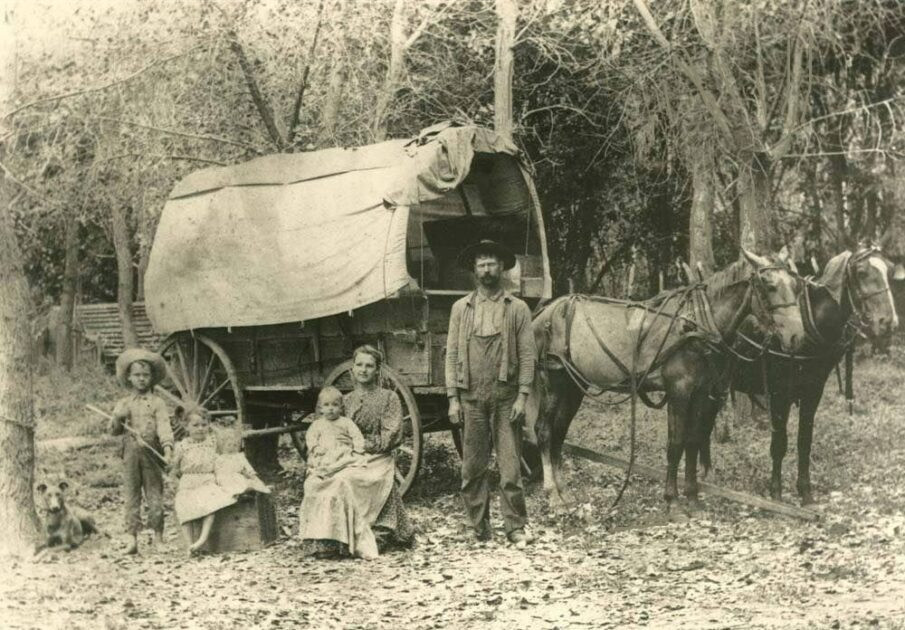
In the summer of 1908, the Smith family of Kansas embarked on a journey emblematic of the American pioneer spirit. With their life’s belongings packed into a covered wagon, they set out across the vast prairies of Kansas, seeking new opportunities and a fresh start. This journey, taken at the dawn of the 20th century, echoed the treks of pioneers from decades past but bore the unique imprint of a family navigating a rapidly changing world.
Preparation for the Journey
The Smith family, consisting of John and Mary Smith and their three children, William, Sarah, and little Thomas, had been planning their move for months. Economic hardships and the lure of fertile land further west drove their decision. With the experience of previous generations to guide them, they meticulously prepared their covered wagon for the journey.
The wagon itself was a sturdy Conestoga, its canvas cover offering protection from the elements. Inside, they packed essentials: non-perishable foodstuffs, cooking utensils, clothing, and bedding. Tools for farming and personal items found their place, and a small amount of cherished family heirlooms made the cut. They also carried a basic first aid kit, mindful of the health risks posed by such a trip.
The Departure
As the rooster crowed on a crisp June morning, the Smith family hitched their two strong draft horses, Buck and Daisy, to the wagon. Neighbors gathered to bid them farewell, offering blessings and small tokens for luck. With a final wave, John cracked the reins, and the wagon lurched forward, beginning the family’s adventure.
The first days were filled with excitement and optimism. The children, eyes wide with wonder, soaked in the changing landscapes. Mary kept a careful journal, noting the flora and fauna they encountered, and John navigated by landmarks and a well-worn map, handed down from his grandfather.
Challenges on the Trail
However, the journey was far from easy. The Smiths faced numerous challenges that tested their resolve. The weather, always unpredictable on the plains, swung from scorching heat to sudden thunderstorms. The wagon’s canvas cover offered limited shelter from torrential rains, and the family huddled together, waiting out the storms.
Food and water supplies also became a concern. The family relied on rivers and streams for water, but dry spells made finding clean water difficult. Hunting supplemented their provisions, with John and William often setting out early to catch rabbits or prairie chickens. Mary’s skill in preserving food was invaluable, ensuring they had sustenance even on lean days.
Health issues were a constant worry. Little Thomas fell ill with a fever that left Mary sleepless with worry. Fortunately, a chance encounter with another traveling family, who had a knowledge of herbal remedies, provided the needed cure, and Thomas soon recovered.
The Spirit of Community
Despite the hardships, the Smiths found camaraderie and support from fellow travelers. They often joined other families in makeshift camps, sharing meals, stories, and songs around the campfire. These gatherings provided much-needed morale boosts and practical assistance, such as repairing broken wagon wheels or sharing surplus supplies.
One notable friendship formed with the Johnson family, who were also traveling westward. Sarah and the Johnson’s daughter, Emma, became fast friends, their laughter ringing out across the prairie. The two families traveled together for several weeks, their combined resources making the journey more manageable.
A New Beginning
After weeks on the trail, the Smith family finally reached their destination: a promising piece of land near the small but growing town of Garden City, Kansas. Here, they would build their new home and start afresh. The journey had been arduous, but it had also been transformative, strengthening the family’s bonds and instilling a deep resilience.
As they set up their new homestead, John and Mary reflected on the journey with pride. They had braved the challenges of the Kansas plains, drawn on their inner strength, and relied on the kindness of strangers. The covered wagon, once a symbol of the unknown, now stood as a testament to their courage and determination.
In the end, the Smith family’s 1908 covered wagon journey was not just a physical relocation but a passage into a new chapter of their lives, marked by hope, perseverance, and the enduring spirit of adventure.

Leave a Reply